Why RPA (Robotic Process Automation)
Robotic Process Automation is economically capable as compared to any other automation solutions. It is the new buzz word in the IT industry. It has shifted the traditional way of doing the business task manually into an automatic task within an organization.
Most people look at the term RPA (Robotic Process Automation) as a picture of a physical robot doing some work according to human instruction such as uploading the bulky goods from the vehicles, or cleaning the house, etc. But the actual picture of the robot is different in reality.
The word robot, which is related to Robotic Process Automation is not a physical Robot. These Robots are virtual systems that efficiently automates repetitive and manual tasks.
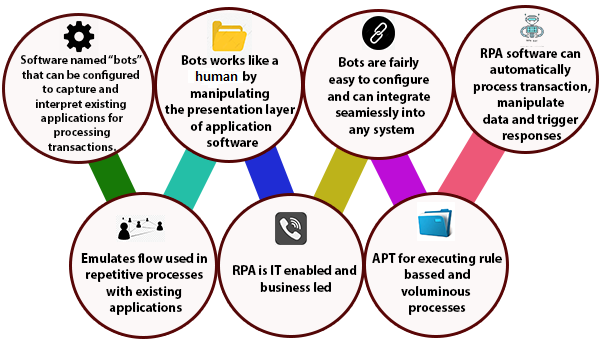
According to the report of March 2017, the researchers and market revealed that the "Robotic Process Automation market is about to reach the USD 2,467 million by 2022.
RPA (Robotic Process Automation) vs. Traditional Automation
Automation is not any new technology in the IT market, but the Robotic Process automation is trending and unique approach to automate the business process. In the traditional automation techniques, the programmer uses API to integrate different systems at one platform, whereas, in RPA, they have realized the use of actions at UI (user interface) level.
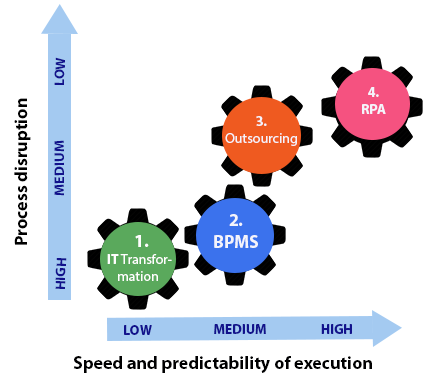
“The software 'robot' is a type of software that replicates human actions and interact with the user interface of the computer system. It operates on the user interface (UI) in the same way as humans would."
Various areas that differentiate the RPA from traditional automation are given below:
| RPA (Robotic Process Automation) | Traditional Automation |
| 1. RPA is copying the actions of the user at the (UI) user interface level. | 1. Traditional automation is based on programming and relies on APIs. In traditional automation, there exist many different integration methods that were used to integrate various systems. |
| 2. The robot acts as human actions in RPA. It exactly follows the same steps provide by the user. So, the user does not need to worry about the complexity of the primary application. | 2. In traditional automation, the developer requires a good understanding of the targeted system. |
| 3. The user has unlimited options to customize the application or software in RPA (Robotic Process Automation). | 3. There is not any source code with software in the traditional automation. The user has limited options to customize the application. |
| 4. We can easily design the inherited products and also build integration with the help of Robotic Process Automation. | 4. The inherited products are not intended and built for the integration according to the traditional automation. |
| 5. Robotic Process Automation can easily use Robust APIs. | 5. Traditional automation doesn’t have robust APIs. |
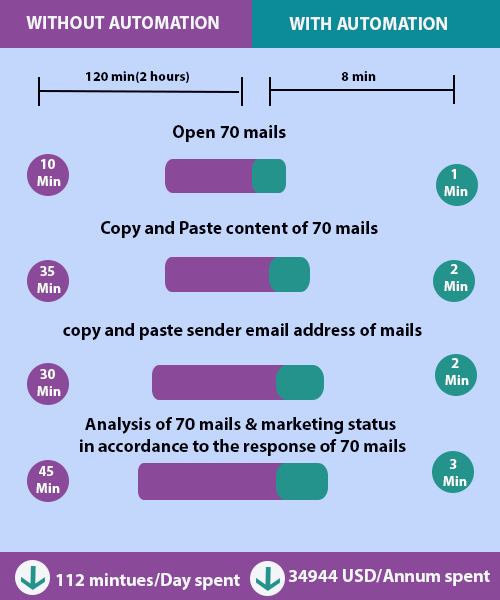
Need of RPA
1. Since it saves a lot of manual documentation work, Robotic Process Automation can be used in payroll processes as well as in new employees joining formalities.
2. It is mainly used in the insurance sector for premium information, processing claims, and clearances.
3. The traveling domain also uses RPA for booking tickets, storing passenger’s details, and also for accounting.
4. RPA is also used in the field of finance, providing account payable services.

Figure: Need for RPA.
5. Robotic Process Automation is used in logistics. Some companies use RPA to contribute to analytics and artificial intelligence with the help of business patterns.
6. RPA is used in the data management field. We can collect, integrate, analyze, and process the data with the help of RPA.
7. The user needs RPA to improve customer service operations for better customer services.
8. The business field requires Robotic Process Automation for automating sales operations. It not only executes faster transactions but also provides higher accuracy.
RPA Benefits
RPA is a game-changer. It is used to save money and time on repetitive manual tasks. It allows the software robot to copy human behavior.
It navigates software enterprises like ERP systems, FSM software, or service management tools with the help of application user interfaces.
Robotic Process Automation (RPA) improves productivity to deliver intelligence data accurately. It provides real-time access to financial data with reporting and analytical capabilities.
The RPA works with a rule-based, regular task that requires manual input. It improves business efficiency and makes the employee more productive.
There are various types of benefits for implementing the Robotic Process Automation at the industry level that is given below:
1. Accuracy
RPA offers improved services that have a higher probability of human error. The Robots are reliable, consistent, and do not complain when they are expected to work tirelessly. RPA provides perfect accuracy in the repetitive task.
Robots have reduced the correction work and improved the quality of output. The most important thing about Robots is that they follow all the rules, producing 100% accuracy in the processed result.
The automation process allows the user to eliminate the errors that are unavoidable in case of manual performance due to a lack of concentration. The better quality means high customer satisfaction rates, which is good for the company's profitability.
The Robotic Process Automation performs error-free work. It provides automation of human tasks with the help of the software, programmed by some specific rules.
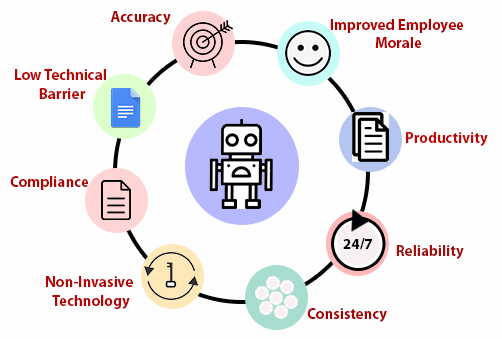
2. Low Technical Barrier
It does not require any programming skills to configure the bot (automated program) or software robot in the RPA (Robotic Process Automation). The automated programs are extremely accurate.
Since the RPA is a code-free technology, any non-technical staff can use the drag and drop process designer to set up the bot and even record their steps for the automation of the process through the process recorder feature.
3. Compliance
RPA as Compliance enabler needs considerably vast financial and human resources. It is very complex to process the heavy-data.
The Robotic Process Automation could be vastly beneficial because of “anti-money laundering” and “know the client “operations.
RPA supports high levels of accuracy as well as cost savings because of this beneficial feature.
4. Non-Invasive Technology
The non-Invasive technology is useful for Robotic Process Automation because it allows the organization to implement the RPA in the non-interruptive way, which makes RPA unique among all types of automation.
This technology is also reducing the need for constant IT involvement. Non-Invasive technology provides the coding abilities to its employees.
5. Improved Employee Morale
Workers are dedicated most of the time to engage themselves in interesting work. RPA handles the business routine tasks in various fields of our day to day life, such as accounting, receivables, and payroll. It may improve the morale in the HR and administrative areas in the business to grow higher.
6. Productivity
Robots can do work 24 X 7 X 365 continuously, without taking any rest. The robots are scheduled to work more efficiently. They do not require breaks, vacations, etc. Robots never delay the work by getting absent at the work front.
Productivity also improves the overall operational efficiency by reducing the current resolution time of any event or procedure. RPA allows the delivery of the service model by increasing its production and accuracy.
7. Reliability
RPA has brought the error processing rate considerably down. It allows faster and easier customization to create new bots (automated programs) that are designed for some specific front-and-back end tasks.
We can conduct a rule-based analysis and make changes to the files or programs due to RPA's flexibility. The RPA bot is also capable of doing all these things.
8. Consistency
Robotic Process Automation provides the benefit of process consistency. Renewable process of income protection claim needs several steps that should be identical for every customer (Identification of the customer, confirmation of disability, validation of product rules, etc.).
These automated steps ensure the customer that they need to take the initiative for the renewable requests instead of going to an insurance agent.
9. Flexibility and Scalability
In RPA technology, if the user wants to increase the processing capacity of multiple robots at any point in time, then it will not cost high. Simply the user has to locate the greater number of robots immediately.
The increment or decrement of robots will depend on the customer’s need. This action can be programmed as a part of a workflow, i.e., resizing is done automatically as per the requirement.
10. Cost savings
Nearly 30% of cost savings are achieved by automating the tasks. The cost of a software robot is less than the salary of a full-time employee.
11. Faster and easier implementation
The insurance company expects the faster and easier implementations of RPA’s existing benefits that are increased the efficiency of claim processing, enhanced accuracy of the manual data input, and quick scalability based on customer’s demand.
RPA Usage
RPA (Robotic Process Automation) is used to automate the workflow, infrastructure, and back-office processes that are labor-intensive.
The software bots (automated programs) can interact with the in-house application, website, user portal, etc. RPA is a software program that runs on the end-user PC, laptop, or mobile device.
RPA automates the HR tasks, including onboarding and offboarding, updating employee information, and the submission process of timesheets.
Robotic Process Automation can be used for obtaining, automating order process and payments, monitoring inventory levels, and tracking the shipments.
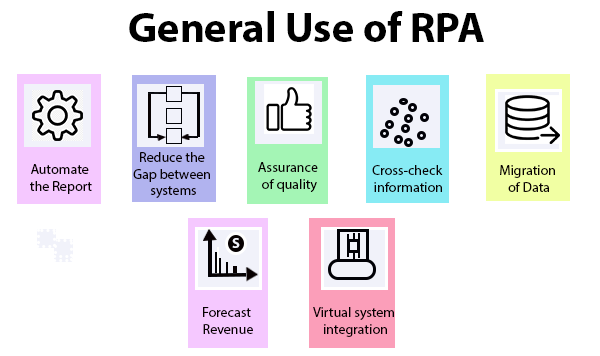
Following are the general use of RPA that is given below:
- Automating the Report
- Reducing the Gap between Systems
- Quality Assurance
- Cross-Checking the Information
- Migration of Data
- Forecast Revenue
- Virtual System Integration
Industry purpose RPA Usage
The RPA is used in different types of industries for several purposes. RPA is used in telecommunication industries for monitoring the CRM subscriber’s feeds, fraud management data, and customer data updates.
It is a form of digital machine labor that replicates human cognitive functions and performs the task accurately and efficiently in various industries.
RPA (Robotic Process Automation) uses software with artificial intelligence and machine learning skills to handle the tasks that previously needed human interaction. There are many industries that are using RPA for producing better results in their business. Following are some industry fields that use RPA, are given below:
- HealthCare
- HR (Human Resources)
- Telecommunications
- Insurance
- Retail Industries
- Travel and Logistics
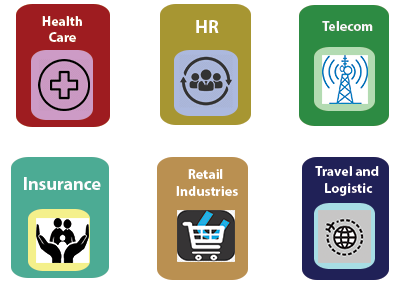
Figure: Industry purpose RPA Usage.
RPA is also used by the manufacturing industry. These types of industries used physical robots to accumulate the test.
Manufacturing companies are optimizing complex back-office operations such as vendor communications, inventory management, procurement, payment processing, and report generation.
Test Automation vs. RPA
There exist multiple overlaps between the test automation tool and the RPA tool. The RPA is not a testing tool, but it could be utilized as a testing tool in the future. The functionalities and different kinds of business processes are automated with the help of RPA (Robotic Process Automation) software.
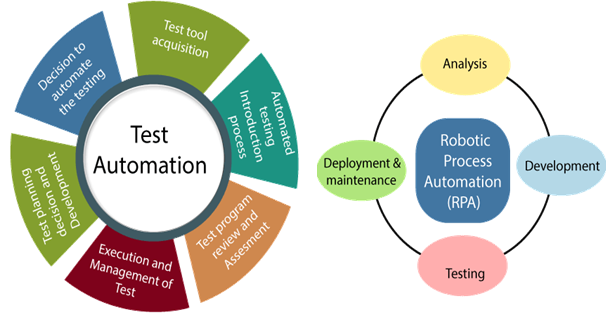
Figure: Difference between RPA and Test Automation.
The user can automate web applications, desktop applications, mobile apps, as well as mainframe-based applications. There are some crucial differences between Test Automation and RPA that are given below:
| Test Automation | RPA (Robotic Process Automation) |
| 1. Test automation reduces test execution time through automation. | 1. The RPA reduces headcount with the help of automation. |
| 2. It automates the repetitive test cases. | 2. RPA can automate repetitive Business processes. |
| 3. Coding Knowledge is required to create the test Scripts in the test automation process. | 3. The coding Knowledge is not necessary for the Robotic Process Automation in development. |
| 4. The test automation can be executed as per the instructions provided by the code. | 4. Many RPA tools come with the artificial intelligence engine and process information like human beings. |
| 5. The products can be automated with the help of Test Automation. | 5. The products, as well as services, are automated with the use of RPA. |